Jeff’s quickie page of vintage ICs/chips
Zilog
 More Zilog notes are here.
More Zilog notes are here.
The Z80 Ain't Dead Yet
was the title of my collection/display for the
VCF (Vintage Computer Fest) East 5.0 in Sept 2008.
I still have a fondness for the Z80 for its easy to use hardware interface
and wide variety of peripherals (parallel ports, sync/async serial ports, DMA, CTC).
It was second sourced by several companies (Mostek, SGS) and evolved
from the Z80 to Z180, Z280 and eZ80.
Hitachi's HD64180 variation was popularized by the
Micromint
SB180 single-board computer.
Micromint is the manufacturing arm of Steve Ciarcia's
Circuit Cellar
(back then in Byte Magazine, now on its own)
The Z80 was the main CPU in desktop computers from around 1976 to the early 80s,
particularly the Radio Shack TRS-80 and Timex/Sinclair 1000 ("the first computer for under USD $100").
Over time, it became embedded into modems, disk controllers, terminal servers and just about anything that required
many serial ports due to the unmatched capabilities of the dual channel SIO (serial I/O chips)
that interfaced to the Z80 CPU with a minimum of components (mostly address decode
since they self-arbitrated the vectored interrupt daisy-chain).
General Instrument



 The GI logo from old to new
The GI logo from old to new
I have an affection for General Instrument chips
since they did fun things. I worked for General Instrument in 1982
but not for the chip division.
Here are the 3 different logos they used:
the swirly "GI" logo (similar to the Penn Central Railroad's
"mating worms"),
then the entire name (right justified) then just the initials.
Popular General Instrument chips were:
- SP0256-017 speech chip. Radio Shack sold them with the data sheet and sample circuits for a talking alarm clock.
- simple UARTS such as AY-5-1012 AY-3-1015D (originally +5, -12v, later +5 only)
- async serial baud rate generator: AY-5-8116 (before being absorbed into the USART)
The 1982 General Instrument microelectronics product guide is a stroll down memory lane
(pun intended: they manufactured memory chips). Here we see
- the first of the PIC chips:
the PIC-16 (but most were mask programmable during manufacture:
no EPROM or flash like today).
I remember the internal posters for the 13 bit PIC 1670.
Why 13 bits? That's what the instruction length optimization said!
Since General Instrument made the chips, they made an external
13 bit ROM for it too.
- The ever popular first generation speech synthesis chips, popular in talking toys.
SP0250 SP0256 SP0232 SP0200 SPR016 SPR032 SPR128
- Teleview Teletext PIC chips, AY-3-1015D uart
and Personal Computer chips: AY-3-8910 sound generator, AY-3-8915 color processor.
- TV Game chips
They were the heart of MANY TV "pong" style games. That's why they were so similar!












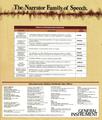 The SP1000 featured speech recognition & Allophone based speech synthesis
The SP1000 featured speech recognition & Allophone based speech synthesis



 Making things talk was quite the "thing" in 1982
Making things talk was quite the "thing" in 1982

 internal newsletter
internal newsletter
my color labels
 I was too cheap to buy the pre-printed chip labels
so I used my technical/drafting pen to make my own.
I was too cheap to buy the pre-printed chip labels
so I used my technical/drafting pen to make my own.
- yellow for logic
- green for things that held their state (latches)
- red for expensive chips

Sometimes being a bit anal-retentive is its own reward.
I saved these spare chip rail end-clips back in the 70s and 80s
when chip rails were plentiful since I worked around EE labs (not anymore).
Now that I'm sorting and handling 25+ year old chips,
some of the rubbery chip rail wedges have become hard and brittle,
so I'm GLAD I have the replacements on hand!
modern chips
And now for something completely different: current chips of interest
The
Freescale family of e-field chips such as the
MC34940/MC33794
allow for interesting sensing of people at distances far greater than capacitive methods.
I got several as part of the Circuit Cellar Freescale Zigbee contest kit.
I'm actively using the PIC-18 series of chips, exploring I2C peripheral chips.
Schweber Electronics Buzz Buzz


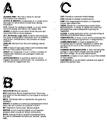
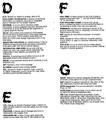
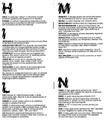
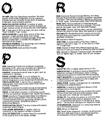
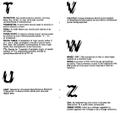 Schweber Electronics Semiconductor Buzz-Words
Schweber Electronics Semiconductor Buzz-Words
I ALWAYS participated in my school science fairs.
In my senior year of high school,
my entry "semiconductors vs. tubes"
finally win the school fair
and competed in the Queens borough-wide science fair.
During the public exhibition, I met a kind fellow who worked for Schweber who send me this folder.
 More Zilog notes are here.
More Zilog notes are here.



 The GI logo from old to new
The GI logo from old to new












 The SP1000 featured speech recognition & Allophone based speech synthesis
The SP1000 featured speech recognition & Allophone based speech synthesis



 Making things talk was quite the "thing" in 1982
Making things talk was quite the "thing" in 1982

 internal newsletter
internal newsletter
 I was too cheap to buy the pre-printed chip labels
so I used my technical/drafting pen to make my own.
I was too cheap to buy the pre-printed chip labels
so I used my technical/drafting pen to make my own.







 Schweber Electronics Semiconductor Buzz-Words
Schweber Electronics Semiconductor Buzz-Words